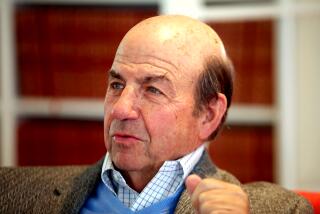‘Nothing Happened and Then It Did: A Chronicle in Fact and Fiction’ by Jake Silverstein

Nothing Happened
and Then It Did
A Chronicle in Fact and Fiction
Jake Silverstein
W.W. Norton: 232 pp., $23.95
People who know Jake Silverstein may be surprised to discover upon reading “Nothing Happened and Then It Did” that he helped find pirate booty in a Louisiana bayou, competed in a poetry competition, spent days with a Mexican American businessman working on a story that he had no hope of ever writing and once shared a ride with a shorthand champion. But they can rest assured that he hasn’t been keeping secrets: Only half the material here is true.
There are eight lightly told stories in the book, most set in southwest Texas and northern Mexico. They begin about 10 years ago, when Silverstein, not long out of college, got a job at the newspaper in Marfa, the Texas town where artist Donald Judd had settled. “I had read a book in which a journalist was described as ‘a roving eyeball looking for truth,’ ” Silverstein writes, “and this had appealed to me. I wanted to be roving and felt that I was capable of being an eyeball.” Between writing about city council meetings, ranches and drought, he did a lot of driving. His stories are as much about the people and places he comes to know as they are about where his mind takes him along the way.
Sun and solitude and desert roads led to hallucinatory leaps. Thinking he’s discovered a way to find Ambrose Bierce, Silverstein starts asking locals where they’ve seen the Devil. Later, following the La Carrera Panamericana car race, he turns up a history of crashes so bloody it makes “Death Race 2000” look like “Mary Poppins.” These stories, so extraordinary and surreal, could not possibly be true. But they are.
Perhaps it was their strangeness that gave Silverstein the idea to fill out the book with fictions. It’s an unusual, counterintuitive move.
In recent years, the fluid boundary between fact and fiction has displaced more than one writer. There was James Frey, whose exaggerated sins set him on Oprah’s couch, apologizing. Or Stephen Glass and Jayson Blair, of the New Republic and the New York Times, respectively, who were caught making things up instead of reporting -- both lost their jobs. Such incidents suggest a rumbling cultural anxiety about truth and fiction, as explored in the new book “Reality Hunger” by David Shields.
Silverstein addresses the issue head on. “I do not wish to deceive by passing off fiction as fact, as so many have done” he writes in the preface, “only to permit the real to mingle with the imagined, as it does in the deserted labyrinth of the mind.”
To do this, he intertwines the two in alternating chapters. When looking at the table of contents, it’s easy enough to tell the difference. But reading through, the stories start to blend. Partly, this is because the truths are outrageous and the fictions easy to swallow, but it is also because Silverstein, the awkward reporter, is a character throughout.
His genial presence, in a beat-up Toyota with plenty of curiosity and workable Spanish, is a constant. Whether he’s writing about retired ranch hands, his landlords, Mexican construction workers or Nazi mechanics, we trust him. He’s as believable about being blindfolded by treasure-hunters in a Louisiana swamp as he is about reading at a commercial poetry contest. (Only one is true.)
His haplessness is endearing. He pursues stories -- conducting interviews; doing research; driving, always driving -- only to discover that they’ve already been written. Tired of being scooped, he moves to the Mexican city of Zacatecas, hoping that he’ll find something nobody is bothering to look for. True to form, he finds a lot of nothing, eventually settling for the story of the much-delayed opening of the region’s first McDonald’s.
When Silverstein is front and center, making wry jokes, musing about the road and what journalism might mean, “Nothing Happened and Then It Did” has a thoughtful momentum. When he stops to report, particularly in the account of the poetry contest, it slows down and becomes more predictable.
The poetry piece also serves another, inadvertent purpose: to highlight a more subtle blurring of the fact and fiction line. Indeed, like all the nonfiction in the collection, it first appeared in Harper’s. The biggest fiction of the book, it turns out, is that Silverstein is hapless; he isn’t, after all. His explanation of how he wound up living in Zacatecas is funny, full of coincidence and a great story, but the truth is that he went there on a Fulbright Fellowship. These days, he lives in Austin, where he is the editor of Texas Monthly.
“It appears that, toward the last, he lied for the sheer joy of lying, long after the time when such lies could have been of benefit to him,” Silverstein quotes from “Lafitte the Pirate” by Lyle Saxon. “. . . This is probably the key to his mysteriousness. He transformed himself into a legend while he was still alive.”
By downplaying his accomplishments, Silverstein has created a legend of a different shape. Throughout the book, he points out the mistakes journalists make, the extreme and futile efforts it can take to get a story right. Sometimes, he reveals, the best story -- the one that is both explanation and inquiry, that is fun and fast and shares surprising insights -- is the one that is a lie.
Kellogg is the lead blogger for Jacket Copy, The Times’ book blog.
More to Read
The biggest entertainment stories
Get our big stories about Hollywood, film, television, music, arts, culture and more right in your inbox as soon as they publish.
You may occasionally receive promotional content from the Los Angeles Times.







